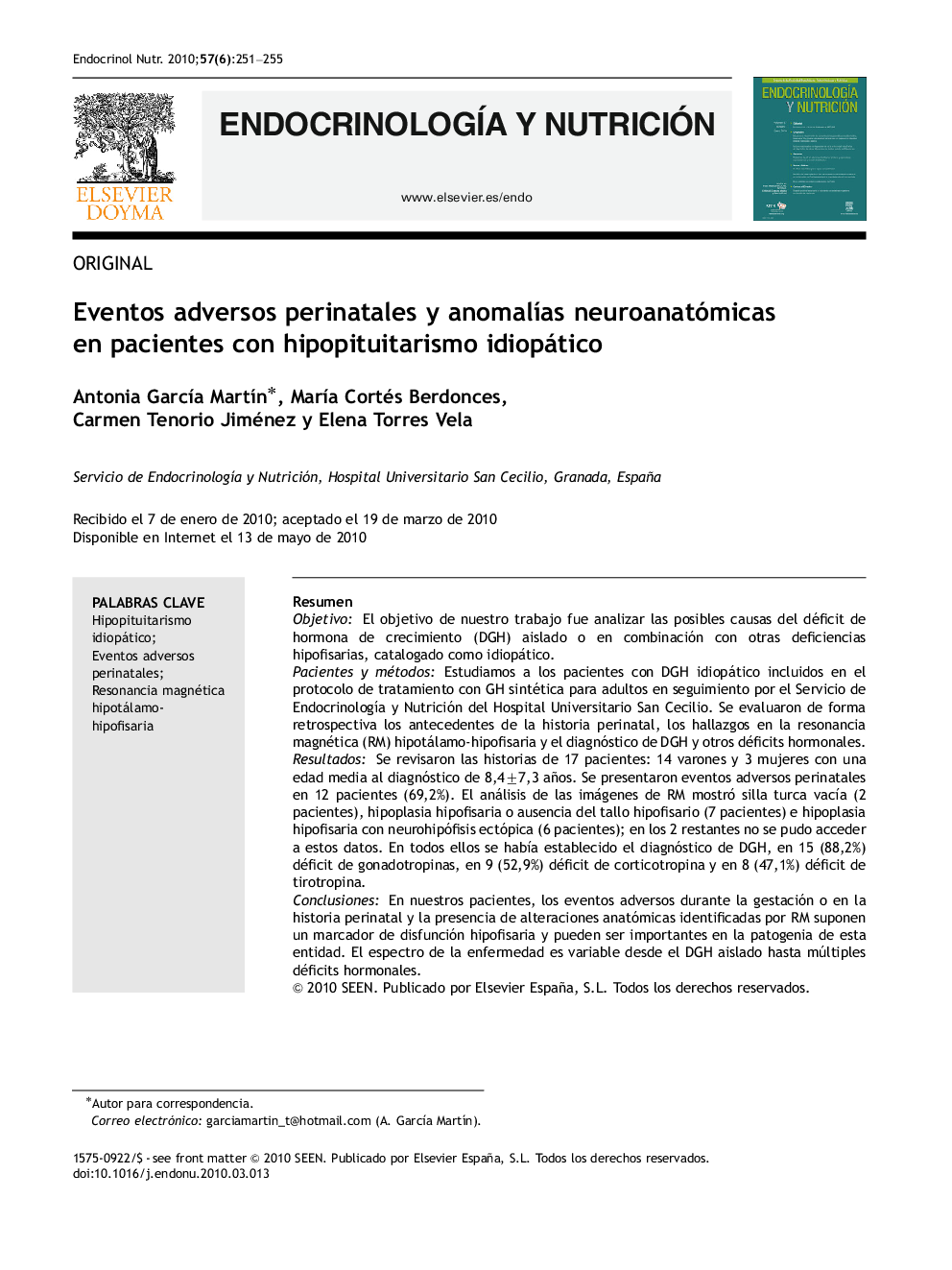| Article ID | Journal | Published Year | Pages | File Type |
|---|---|---|---|---|
| 2774047 | Endocrinología y Nutrición | 2010 | 5 Pages |
ResumenObjetivoEl objetivo de nuestro trabajo fue analizar las posibles causas del déficit de hormona de crecimiento (DGH) aislado o en combinación con otras deficiencias hipofisarias, catalogado como idiopático.Pacientes y métodosEstudiamos a los pacientes con DGH idiopático incluidos en el protocolo de tratamiento con GH sintética para adultos en seguimiento por el Servicio de Endocrinología y Nutrición del Hospital Universitario San Cecilio. Se evaluaron de forma retrospectiva los antecedentes de la historia perinatal, los hallazgos en la resonancia magnética (RM) hipotálamo-hipofisaria y el diagnóstico de DGH y otros déficits hormonales.ResultadosSe revisaron las historias de 17 pacientes: 14 varones y 3 mujeres con una edad media al diagnóstico de 8,4±7,3 años. Se presentaron eventos adversos perinatales en 12 pacientes (69,2%). El análisis de las imágenes de RM mostró silla turca vacía (2 pacientes), hipoplasia hipofisaria o ausencia del tallo hipofisario (7 pacientes) e hipoplasia hipofisaria con neurohipófisis ectópica (6 pacientes); en los 2 restantes no se pudo acceder a estos datos. En todos ellos se había establecido el diagnóstico de DGH, en 15 (88,2%) déficit de gonadotropinas, en 9 (52,9%) déficit de corticotropina y en 8 (47,1%) déficit de tirotropina.ConclusionesEn nuestros pacientes, los eventos adversos durante la gestación o en la historia perinatal y la presencia de alteraciones anatómicas identificadas por RM suponen un marcador de disfunción hipofisaria y pueden ser importantes en la patogenia de esta entidad. El espectro de la enfermedad es variable desde el DGH aislado hasta múltiples déficits hormonales.
ObjectiveTo analyze the possible causes of growth hormone (GH) deficiency, whether isolated (GHD) or in combination with other pituitary deficiencies classified as idiopathic.Patients and methodsWe studied patients with idiopathic GHD included in a protocol of recombinant GH treatment in adults attending the outpatient clinic of the Endocrinology and Nutrition Service of the San Cecilio University Hospital. Perinatal history, findings on magnetic resonance imaging (MRI) of the hypothalamic-pituitary axis and diagnosis of GHD and other deficiencies were retrospectively evaluated.ResultsA total of 17 patients were included: 14 men and 3 women with a mean age at diagnosis of 8.4±7.3 years. Perinatal adverse events occurred in 12 patients (69.2%). MRI showed empty sella (2 patients), pituitary hypoplasia or absence of the pituitary stalk (7 patients) and pituitary hypoplasia with ectopic posterior pituitary gland (6 patients); in the remaining 2 patients these data were not available. All had an established diagnosis of GHD: 15 with (88.2%) gonadotropin deficiency, 9 (52.9%) with adrenocorticotropic hormone (ACTH) deficiency and 8 (47.1%) with thyroid-stimulating hormone (TSH) deficiency.ConclusionsIn our patients, adverse events during pregnancy or the perinatal period and the presence of anatomical abnormalities identified by MRI are a marker of pituitary dysfunction and may be important in the pathogenesis of this entity. The clinical spectrum of disease varies from isolated GH deficiency to multiple pituitary hormone deficiencies.
